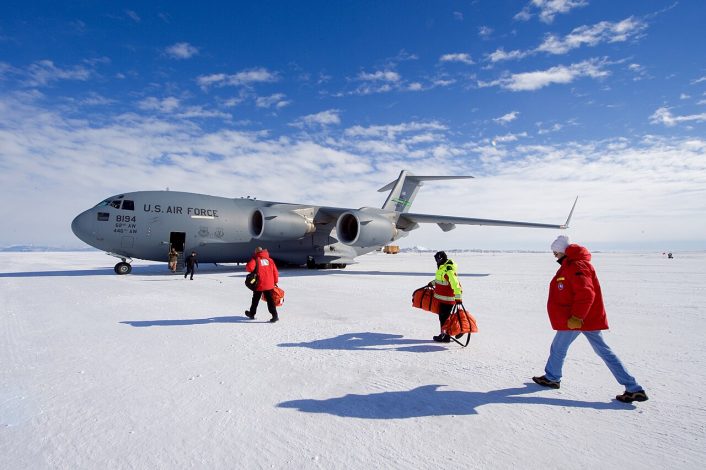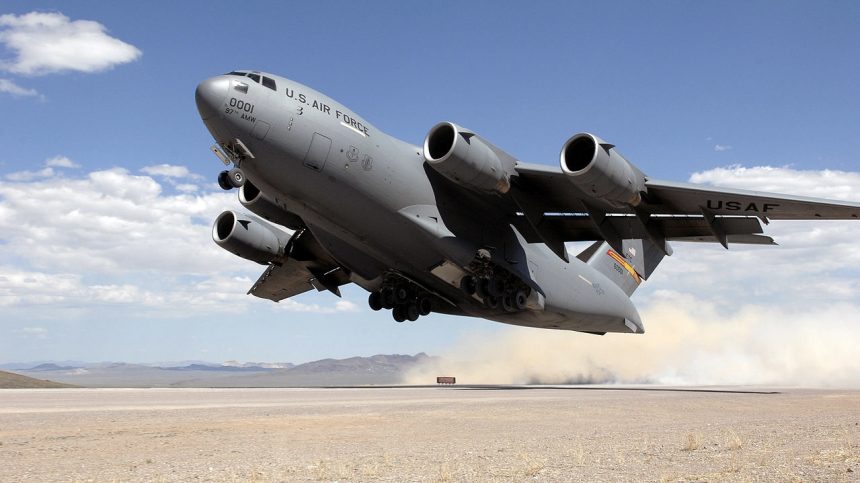Proving to be one of the most flexible transport aircraft in United States Air Force history, the McDonnell Douglas/Boeing C-17 Globemaster III provides improved airlift capabilities close to battlefields, humanitarian missions, and peacekeeping operations, with the ability to operate from austere airfields in remote areas.
C-17 Origins
The U.S. Department of Defense (DoD) initiated a program in December 1979, known as the Cargo-Experimental (C-X) competition, as a means of finding a new strategic airlift aircraft that was jet-powered. Other requirements included a rear loading large-volume cargo compartment that could accommodate tracked and wheeled vehicles, the capability of airdropping troops and necessary cargo loads directly into a combat zone, and possessing STOL (Short Takeoff and Landing) capabilities.
McDonnell Douglas had developed a prototype known as the YC-15 for the United States Air Force (USAF) in a competition known as the Advanced Medium STOL Transport (AMST) to replace the Lockheed C-130. The completion, however, was cancelled, but the basic design of the YC-15 would be redesigned to a larger version with swept wings and more powerful engines. This new aircraft would compete in the C-X program to replace the aging Lockheed C-141 Starlifter, whose origins dated back to the early 1960s.

In August 1981, McDonnell Douglas was chosen to build the company’s proposal, known as the C-17. The aircraft would become known as the C-17A Globemaster III, sharing the Globemaster title with two previous cargo planes, the Douglas C-74 Globemaster and the Douglas C-124 Globemaster II. Delays and development problems pushed the project into the late 1980s, with the first flight finally taking place on Sept 15, 1991, from McDonnell Douglas’ plant in Long Beach, California. The first six aircraft were extensively tested at Edwards Air Force Base (AFB), California. Two static airframes were produced and used for load testing.
Issues arose in October 1992 with static testing of the wing of the C-17, resulting in redesigns and further delays, cost overruns and demands by the DoD to solve the issues or face cancellation. Problems meeting other specifications persisted through the early to mid-1990s, with orders for the aircraft being reduced as a result. However, most issues with the C-17 were resolved by September 1995, just a few months after the first squadron had been declared operational the previous January.
In 1997, McDonnell Douglas merged with Boeing, resulting in once downsized orders for the aircraft to again be increased due to a price cut offered by Boeing. Eventually the USAF would order 224 C-17s, with other operators including Australia, Canada, India, Kuwait, United Kingdom, United Arab Emirates, Qatar, and a Strategic Airlift Capability Heavy Airlift Wing consisting of a multi-nation effort based in Hungary.
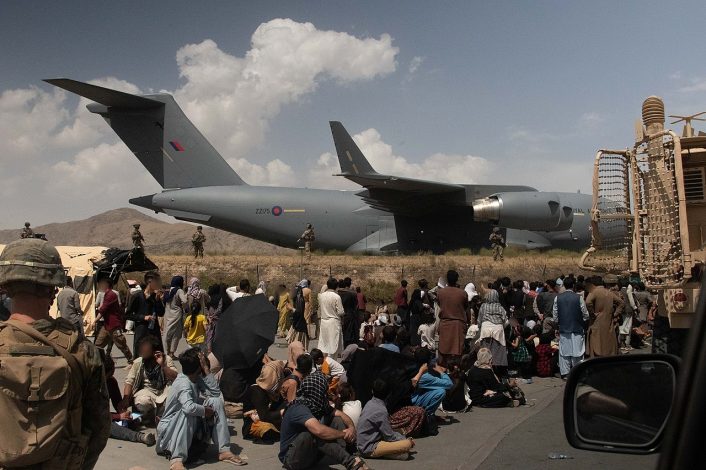
C-17A Roles and Specifications
Performing duties primarily as a strategic airlift aircraft, the C-17 also fills secondary roles in special operations, tactical airlift, and aeromedical evacuation. The cargo compartment can hold a variety of military necessities including: eighteen fully loaded 88” x 108” pallets each with up to 10,000 lb of cargo; forty containers used in airdrops known as Container Delivery System (CDS); a single M-1 Abrams main battle tank weighing 69 tons; up to three M2 Bradley infantry fighting vehicles; three AH-64 Apache attack helicopters; over one hundred troops or forty-eight litter patients along with fifty-four ambulatory patients, just to name a few examples, with various combinations thereof possible as well.
Cargo is loaded through a large rear door that doubles as a ramp, and the cargo floor is reversible between a solid surface and rollerized conveyers, depending on cargo loading needs. The C-17 is capable of airdropping both fully-equipped paratroopers and cargo. The maximum payload capacity of the aircraft is 170,900 lb.
Crewed by a pilot, co-pilot, and loadmaster, the C-17 has an overall length of 174 ft, a height of 55 ft at the tail, and a wingspan of 169 ft 10 in. Power is derived from four Pratt & Whitney F117-PW-100 turbofans each generating 44,400 pounds of thrust. The engines have thrust reversers that direct exhaust upwards and forward, lessening the chances of ingesting runway debris as well as providing thrust to move the aircraft backwards if needed, and can also be employed in flight to add drag to maximum-rate descents. The C-17’s maximum speed is 570 mph and it has a service ceiling of 45,000 ft. Empty the Globemaster III has a maximum range of 4,700 nautical miles without refueling, while in reality it has an unlimited range due to inflight refueling capabilities.
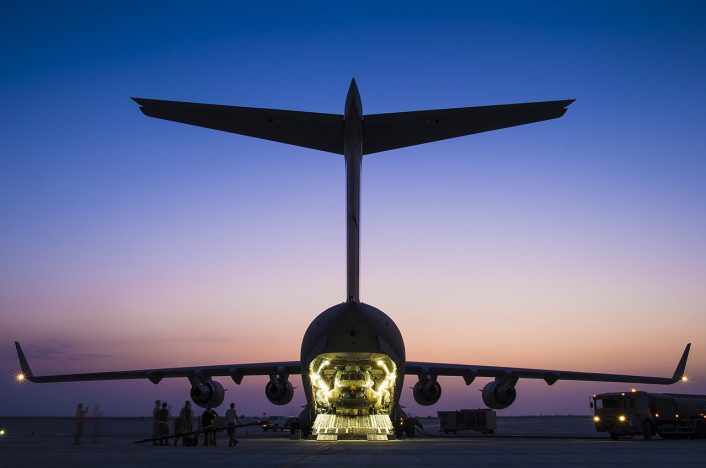
Impressive STOL Performance
The C-17 is credited with more record-breaking milestones than any other airlifter in history, setting a total of 33 world records during initial flight testing at Edwards AFB. Perhaps one of the most impressive records set was the record for STOL, when a C-17 carrying a payload of 44,000 lb took off in a distance less than 1,400 ft, carrying the payload to altitude, and upon returning it landing in a distance less than 1,400 ft. Normal runway requirements for the aircraft are a length of at least 3,000 ft with a width of at least 90 ft.
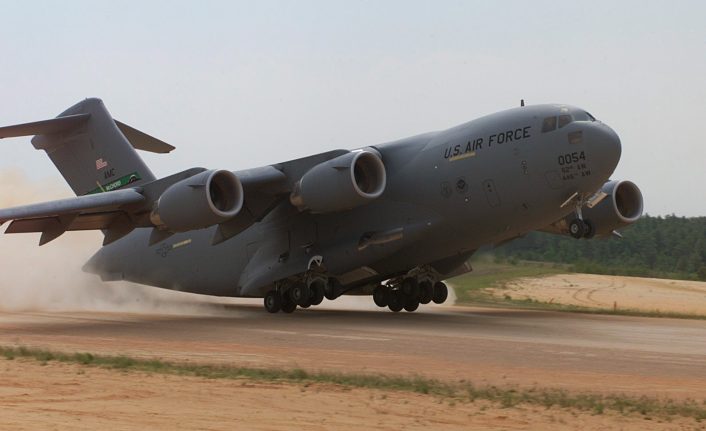
The Globemaster III achieves such remarkable STOL performance by utilizing a system known as “powered lift” or “blown flaps”, which allows the aircraft to make slower and steeper approaches with heavy loads by directing engine exhaust flow below and through slotted flaps to produce additional lift. During takeoffs and landings, the trailing edge flaps are extended into the exhaust flow from the engines and deflected downwards by the slotted flaps, augmenting lift.
Utilizing a three-point star turn and backing capability, the aircraft can turn around on the ground in less than 80 ft. These attributes in conjunction with rugged landing gear allow this airlifter to takeoff or land just about anywhere on the globe, affording needed weapons, troops, supplies, equipment, humanitarian needs, or medical evacuations in close proximity to affected areas.
